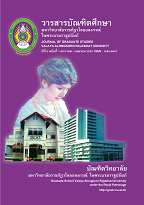ตัวแบบกลยุทธ์ทางการตลาดบริการสำหรับผู้ประกอบการธุรกิจนำเที่ยวระหว่างประเทศไทย/จีน A MODEL OF SERVICE MARKETING STRATEGY FOR THAILAND’S TRAVEL AGENT COMPANIES IN INTERNATIONAL TOUR BUSINESS MANAGEMENT OF THAILAND/CHINA
Main Article Content
Abstract
บทคัดย่อ
การศึกษาวิจัย เรื่องนี้ มีวัตถุประสงค์ในการศึกษา 1) เพื่อสำรวจสภาพและความคิดเห็นของบริษัทตัวแทนท่องเที่ยวจีน (Travel Agents) ในการทำธุรกิจร่วมกับผู้ประกอบการธุรกิจนำเที่ยวของไทย 2) เพื่อสำรวจสภาพและแนวทางการให้บริการของผู้ประกอบการธุรกิจนำเที่ยวของไทยต่อนักท่องเที่ยวชาวจีน 3) เพื่อสำรวจความต้องการของนักท่องเที่ยวชาวจีนที่มีต่อกระบวนการตัดสินใจเลือกใช้บริการผ่านบริษัทตัวแทนท่องเที่ยวจีนในการเดินทางมาท่องเที่ยวยังประเทศไทย และ 4) เพื่อกำหนดกลยุทธ์ทางการตลาดบริการสำหรับผู้ประกอบการธุรกิจนำเที่ยวระหว่างประเทศไทย/จีน โดยใช้ระเบียบวิธีวิจัยแบบผสมผสานระหว่าง การวิจัยเชิงคุณภาพ (Qualitative Research) และ การวิจัยเชิงปริมาณ (Quantitative Research) ซึ่งมีเครื่องมือที่ใช้ในการเก็บรวบรวมข้อมูล ประกอบด้วย การสัมภาษณ์เชิงลึก (In-Depth Interview) การออกแบบสอบถาม (Questionnaire) และ การสัมภาษณ์กลุ่มย่อย (Focus Group) กลุ่มตัวอย่างที่ศึกษาในครั้งนี้ ได้แก่ ตัวแทนผู้บริหาร หรือผู้จัด การฝ่ายการตลาด ของบริษัทตัวแทนท่องเที่ยวจีน (Travel Agents) จำนวน 8 แห่ง ตัวแทนผู้บริหาร หรือ ผู้จัดการฝ่ายการตลาด ของบริษัทนำเที่ยวของไทย จำนวน 10 แห่ง ตัวแทนผู้ที่มีส่วนเกี่ยวข้องภาครัฐ ผู้เชี่ยวชาญ หรือ ผู้มีประสบการณ์ด้านการท่องเที่ยวระหว่างประเทศไทย/จีน และนักวิชาการด้านการท่องเที่ยว จำนวน 5 ราย และ ข้อมูลทุติยภูมิที่ได้จากบทสัมภาษณ์ของผู้สื่อข่าว เอกสารวิชา การ บทความ รวมถึง ข้อมูลจากนักท่องเที่ยวชาวจีนที่เคยเดินทางมาท่องเที่ยวที่ประเทศไทยอย่างน้อยหนึ่งครั้ง โดยผ่านการใช้บริการ บริษัทนำเที่ยวของไทย จำนวนทั้งสิ้น 400 คน โดยกลุ่มตัวอย่างเป็นหลักเกณฑ์ที่ไม่ใช้ความน่าจะเป็นในการสุ่มตัวอย่าง (Non-Probability Sampling) สำหรับข้อมูลเชิงคุณภาพ ใช้วิธีสุ่มตัวอย่างโดยวิธีบอกต่อ หรือ วิธีสุ่มตัวอย่างแบบเครือข่ายจากการสัมภาษณ์ตัวแทนผู้บริหาร หรือผู้เชี่ยวชาญ และข้อมูลเชิงปริมาณ ใช้วิธีสุ่มตัวอย่างแบบเจาะจง จากนักท่องเที่ยวชาวจีนที่เคยเดินทางมายังประเทศไทย สถิติที่ใช้ในการวิเคราะห์ข้อมูล ได้แก่ การแจกแจงความถี่ (Frequencies Distribution) ค่าร้อยละ (Percentage) ค่าเฉลี่ย (Mean) และค่าส่วนเบี่ยงเบนมาตรฐาน (Standard Deviation) สำหรับสถิติอ้างอิง ทำการทดสอบสมมติฐาน และ ค้นหาตัวแบบกลยุทธ์นั้น เลือกใช้การวิเคราะห์องค์ประกอบ (Factor Analysis) และการวิเคราะห์โมเดลสมการโครงสร้าง (Structural Equation Modeling: SEM)
ผลการวิจัยพบว่า
ตัวแบบกลยุทธ์ทางการตลาดบริการสำหรับผู้ประกอบการธุรกิจนำเที่ยวระหว่างประเทศไทย /จีน เป็นการวิเคราะห์ความสอดคล้องที่ได้จาก การสัมภาษณ์เชิงลึก กลุ่มผู้ประกอบการธุรกิจนำเที่ยวระหว่างประเทศไทย /จีน และ ผลจากการวิเคราะห์องค์ประกอบ (Factor Analysis) ด้วยกระบวนการ วิเคราะห์องค์ประกอบเชิงสำรวจ (Exploratory Factor Analysis : EFA) และ ทำการตรวจสอบ ความกลมกลืนของโมเดลแบบข้อมูลเชิงประจักษ์ในภาพรวม (Overall Model Fit Measure) และประเมินความกลมกลืนของผลลัพธ์ในส่วนประกอบที่สำคัญของโมเดล (Component Fit Measure) โดยใช้ การวิเคราะห์องค์ประกอบเชิงยืนยัน (Confirmatory Factor Analysis : CFA) ซึ่งได้ผลการวิจัย ด้วยการพัฒนาจากเทคนิค การวิเคราะห์องค์ประกอบเชิงยืนยันอันดับสาม (Third Order Confirmatory Factor Analysis) สามารถนำเสนอได้เป็น ตัวแบบกลยุทธ์ “PRO-ACT” ประกอบด้วย 6 กลยุทธ์ คือ กลยุทธ์ที่เกี่ยวข้องกับการบริการอย่างมีระดับ ด้วยความยินดี และ เต็มใจบริการ (People Oriented) กลยุทธ์ส่งเสริม และเพิ่มศักยภาพให้กับธุรกิจ ด้านภาพลักษณ์ และชื่อเสียง (Reputation) กลยุทธ์ที่เกี่ยวข้องกับโอกาส และสิ่งที่เกื้อหนุนทางการตลาด ของความเป็นประชาคมอาเซียน ภาคบริการ การท่องเที่ยว (ASEAN/Service Oriented) กลยุทธ์ที่เป็น การสร้างความเชื่อมั่นให้แก่นักท่องเที่ยว ด้วยรูปแบบของการรับรอง และมีความเชื่อมั่น (Assurance) กลยุทธ์การนำเสนอการบริการแบบเหนือระดับของความหลากหลาย และความเหมือนที่แตกต่างบนความต่างที่เหมือนกันของการบริการที่ได้รับการเลือกสรร (Choices of Product) กลยุทธ์การเตรียมความพร้อมในการทำงานแบบบูรณาการ โดยมีความร่วมมือกับหลายๆหน่วย เพื่อการบริการที่มีความฉับไว สม่ำเสมอ และรวดเร็ว (Timeliness)
ABSTRACT
The purposes of this research were 1) to survey the conditions and opinions of Chinese Travel Agents on doing business with Thai travel agents, 2) to survey conditions and service policy of Thai travel agents to Chinese tourists, 3) to survey the needs of Chinese tourists on the decision-making process in selection of services for travelling to Thailand through Chinese travel agents and 4) to determine a marketing strategy for travel agent companies between Thailand/China. This research combined a research methodology between qualitative research and quantitative research, with tools for data collection including; in-depth interviews, questionnaires and focus group interviews. Samples of this study were management representatives or marketing managers of 8 Chinese travel agents, management representative or marketing managers of 10 Thai travel agents, 5 relevant representatives of the government sector, Thailand/China tourism experts and tourism scholars. The secondary data was obtained from the interviews by journalists, academic documents, articles, and the information from 400 Chinese tourists who have travelled to Thailand at least once through Thai travel agents. The samples of this study were randomized by non-probability sampling. Qualitative data was obtained by the use of snowball sampling or network sampling from management representatives or experts who have been interviewed. As well, quantitative data was obtained by the use of purposive random sampling from Chinese tourists who have visited Thailand. Statistics used for data analysis were frequency distribution, percentages, mean and standard deviation. Referable statistics for hypothesis test and statistical search were calculated by factor analysis and Structural Equation Modeling (SEM).
The results showed that:
Service marketing strategy presentations for Travel Agency Companies of Thailand/China that analyses compatibility obtained from in-depth interview, travel agents groups of Thailand/China and result from factor analysis with Exploratory Factor Analysis (EFA) process, verification of conformity of Overall Model Fit Measure, and evaluation conformity of result in the important component of Model (Component Fit Measure) were analyzed by using Confirmatory Factor Analysis (CFA). The research result obtained from the development of Third Order Confirmatory Factor Analysis could be presented as “PRO-ACT” strategy, consisting of 6 strategies namely P-Strategy which related to high class services with welcome and service mind (People oriented), R-Strategy which encouraged and enhance business potential in the form of image and reputation (Reputation), O-Strategy which related to opportunity and marketing support of ASEAN, tourism service sector (ASEAN/Service Oriented), A-Strategy which built confidence of tourists in the form of assurance, C-Strategy which was the presentation on privilege service of diversity and different similarity on same difference, choice of product service, and T-Strategy which prepared readiness for integrated working and collaborating with various agencies with promptness, constancy and fastness (Timeliness).
Article Details
บทความทุกเรื่องได้รับการตรวจความถูกต้องทางวิชาการโดยผู้ทรงคุณวุฒิ ทรรศนะและข้อคิดเห็นในบทความวารสารบัณฑิตศึกษา มหาวิทยาลัยราชภัฏวไลยอลงกรณ์ ในพระบรมราชูปถัมภ์ มิใช่เป็นทรรศนะและความคิดของผู้จัดทำจึงมิใช่ความรับผิดชอบของบัณฑิตวิทยาลัย มหาวิทยาลัยราชภัฏวไลยอลงกรณ์ ในพระบรมราชูปถัมภ์ กองบรรณาธิการไม่สงวนสิทธิ์การคัดลอก แต่ให้อ้างอิงแหล่งที่มา


